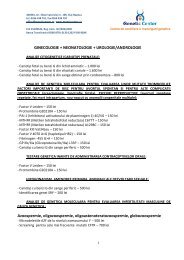Create successful ePaper yourself
Turn your PDF publications into a flip-book with our unique Google optimized e-Paper software.
The mammary pump collects fluid<br />
from the nipple and the smear is<br />
applied and stained on slides by using<br />
the Papanicolaou and Diff-Quick techniques.<br />
The Masood (35) semi-quantitative<br />
cytology score is used to classify<br />
the breast lesions (Table 4). Classical<br />
cytology and liquid-cytology with centrifuge<br />
techniques can be used as well.<br />
The mammary pump is a complementary<br />
technique that increases the<br />
numbers of cells used in the diagnosis<br />
of breast disease. It applies to the<br />
evaluation of any nipple discharge<br />
and tumours in close proximity to the<br />
nipple, and may be used as an adjunct<br />
to FNA. The accuracy of the mammary<br />
pump in the detection of abnormal cells<br />
is 84% for typical hyperplasia lesions,<br />
61% for atypical hyperplasia and 70% for<br />
intraductal carcinoma. These findings<br />
represent the correct diagnosis of the<br />
cytology specimen obtained by the<br />
mammary pump compared with the<br />
histological findings of the surgical<br />
biopsy. The technique has accuracy<br />
greater than 80% in the diagnosis of invasive<br />
ductal and lobular cancers, when<br />
the lesion is less than 4-5 cm from the<br />
nipple. Therefore, the technique can<br />
be used in the early diagnosis of breast<br />
cancer and the positive results may be<br />
used in the design of future studies.<br />
Ductography<br />
Ductography (galactography) is performed<br />
by dilatation, catheterization<br />
and injection of a water-soluble contrast<br />
by a 2cc Telebrix syringe. Craniocaudal,<br />
lateral and compression views are obtained<br />
(Image 8). The results may be<br />
characterized as Normal, Ductal dilatation,<br />
Filling defect or Cutoff sign (26) .<br />
Vol. 4, Nr. 4/decembrie 2008<br />
Image 8<br />
It has been shown to be accurate in<br />
providing the location and depth of<br />
ductal abnormalities when a single duct<br />
is identified as the source.<br />
Data regarding the location of the<br />
lesion greatly facilitate biopsy, especially<br />
with deep lesions. Galactography-aided<br />
wire or coil localization is a practical<br />
localization method for intraductal<br />
lesions not detectable on mammography<br />
or sonography (36) . It improves the diagnostic<br />
yield of surgical biopsy from 67% in<br />
non-studied patients to 100% in patients<br />
receiving a ductography. After the lesion<br />
has been localized, excision will follow.<br />
Nevertheless, ductography cannot be<br />
effectively used for the differentiation of<br />
a benign versus a malignant lesion (37) .<br />
im m u n o c h e m i c a l / he m o c c u l t<br />
(Beckman-Coulter, Palo Alto, CA)<br />
The identification of blood in the<br />
fluid (blood in small quantities) may<br />
be potentially useful with concomitant<br />
cytological review. Blood identification<br />
kits with the Hemoccult technique<br />
are useful, but not necessarily in the<br />
prediction of the final pathology findings.<br />
The positive predictive value<br />
of the technique is



